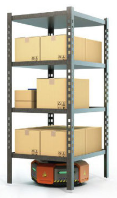Robots increase warehouse productivity
by Dick Friedman
Several types of robots can increase warehouse productivity, and are now affordable and user-friendly. But for a few reasons, not all distributors are able to utilize them now or in the near future.
Types of robots
Some of the robots described here are termed “collaborative,” which means that to one extent or another, they work with a human rather than alone. The robots perform repetitive, non-judgmental tasks (such as moving pallets) while people perform tasks requiring intelligence (such as reading a mangled product description on a carton). Other types of robots are termed, “unassisted,” which means that they perform judgmental tasks – via advanced technology.
Unassisted Truck Unloading and Loading robots use vision technology and bar code reading to unload pallets from a truck and move each pallet to the floor in front of a system-defined storage location. At that point, the put away task becomes collaborative – a human uses a forklift to put each pallet into the targeted storage location. “Loading” robots move a pallet from a floor location into a designated truck, and position it to maximize space utilization. Collaborative versions of unloading/loading robots are directed by humans, which is not as efficient, but cost much less.
Unassisted Bin and Case-picking robots use advanced technology to literally pick individual products and cases and place them on a cart or pallet or conveyor, or in a tote or carton. If you are envisioning a robot with eyes and arms and hands with fingers, you are correct.

Palletizing robots are controlled by humans and pick up pieces or cases or cartons (from carts or dollies) and position them on an outbound pallet, one layer at a time. (As technology advances, cost-effective unassisted versions of this type of robot will become available).
Challenges
Three kinds of software are required, starting with a modern Enterprise Resources Planning (ERP) system, which is used to enter data on sales orders (that will eventually be picked in the warehouse), manage sales order data (make substitutions), determine when products need to be purchased, and generate POs (which when fulfilled are received into the warehouse). The ERP system is connected to a Warehouse Management System (WMS), which is needed to receive product, track the storage location and quantity on hand of each product, track the quantity picked/moved, interface with bar code readers (such as for picking) and generate various kinds of labels and documents. The ERP system passes data to the WMS, and receives data from it. The WMS must be integrated with a Warehouse Execution System (WES), which physically controls the robots (by transmitting signals and data to them, and receiving back signals and data).
In addition to software programs, another prerequisite is that a bar coded location-ID label is needed for every storage location; each piece/case/carton must contain a product-identifying bar code label; for mixed-product pallets, the WMS must generate a
“license plate,” a unique serial number, which is associated with data for each product on that pallet.
In each warehouse, at least two computer-skilled people are needed for training robots, even the collaborative type. As warehouse conditions change, the robots need to be re-trained. One of those people could be the IT manager, but locating a second person within the organization could be a challenge. The warehouse employees who collaborate with robots must also be tech friendly and open to training.
Although robots can increase productivity, they don’t do much to increase accuracy, and might even decrease it. So a strong prerequisite for robotics is that the customer-impacting error-rate in the warehouse must be very low. In other words, there should be very few instances of customers receiving the wrong product or less product than ordered and promised.
Finally, although modern robots can increase productivity, they are still expensive, even the collaborative types.
Warehouse robots have gotten to the point that sizeable distributors should explore the feasibility (including prerequisites) and cost of using them, but not until the warehouse error rate is very, very low.
 Dick Friedman helps fastener, tool, industrial and MRO distributors prevent warehouse mistakes that lose sales and customers, and helps determine if robots or other forms of automation/mechanization would be practical and cost-justified. He has even helped increase warehouse accuracy for distributors that are scanning bar codes but not achieving a high level of accuracy; and helped determine if specialized software or automation should be obtained. Dick does not sell systems, software or warehouse technology; he has an engineering degree, and is an objective Certified Management Consultant. Contact him via www.GenBusCon.com for a FREE consultation or more information.
Dick Friedman helps fastener, tool, industrial and MRO distributors prevent warehouse mistakes that lose sales and customers, and helps determine if robots or other forms of automation/mechanization would be practical and cost-justified. He has even helped increase warehouse accuracy for distributors that are scanning bar codes but not achieving a high level of accuracy; and helped determine if specialized software or automation should be obtained. Dick does not sell systems, software or warehouse technology; he has an engineering degree, and is an objective Certified Management Consultant. Contact him via www.GenBusCon.com for a FREE consultation or more information.
This article originally appeared in the July/August 2018 issue of Industrial Supply magazine. Copyright 2018, Direct Business Media.














